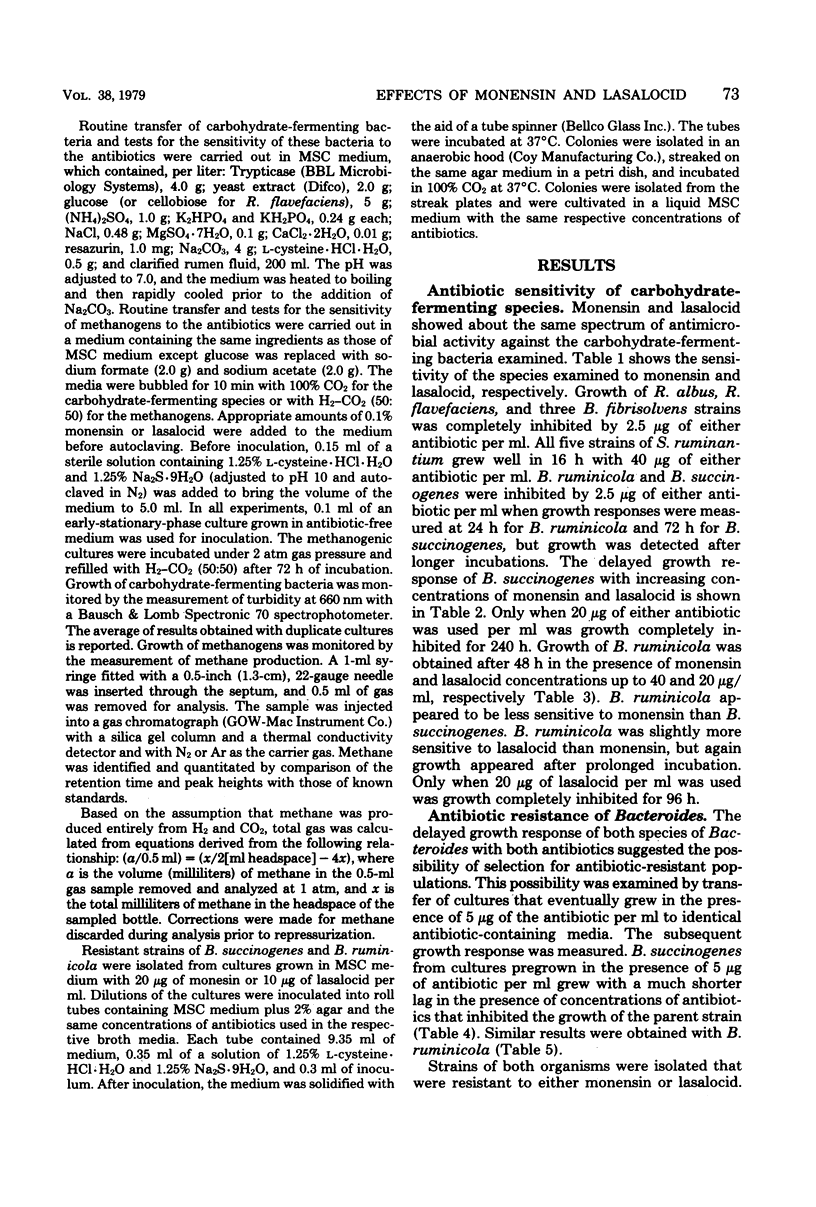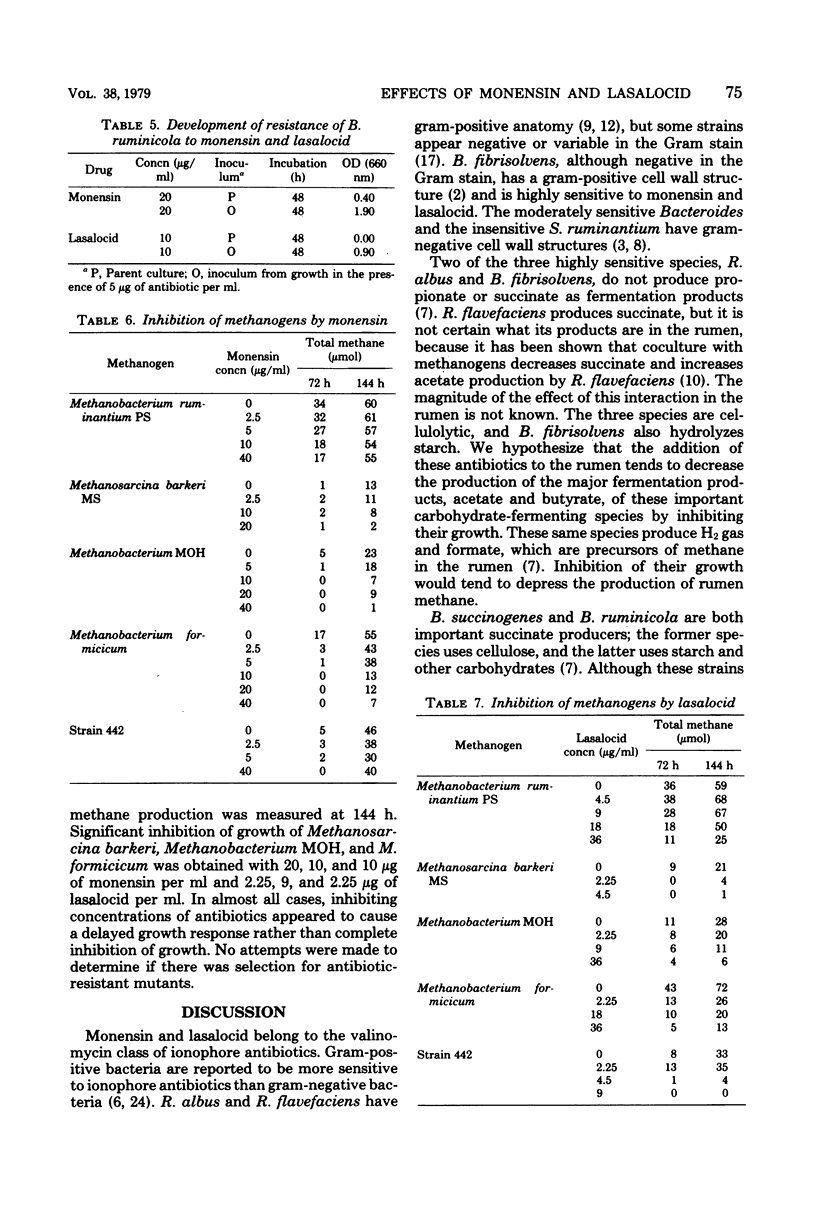Abstract
It is thought that monensin increases the efficiency of feed utilization by cattle by altering the rumen fermentation. We studied the effect of monensin and the related ionophore antibiotic lasalocid-sodium (Hoffman-LaRoche) on the growth of methanogenic and rumen saccharolytic bacteria in a complex medium containing rumen fluid. Ruminococcus albus, Ruminococcus flavefaciens, and Butyrivibrio fibrisolvens were inhibited by 2.5 μg of monensin or lasalocid per ml. Growth of Bacteroides succinogenes and Bacteroides ruminicola was delayed by 2.5 μg of monensin or lasalocid per ml. Populations of B. succinogenes and B. ruminicola that were resistant to 20 μg of either drug per ml were rapidly selected by growth in the presence of each drug at 5.0 μg/ml. Selenomonas ruminantium was insensitive to 40 μg of monensin or lasalocid per ml. Either antibiotic (10 μg/ml) inhibited Methanobacterium MOH, Methanobacterium formicicum, and Methanosarcina barkeri MS. Methanobacterium ruminantium PS was insensitive to 40 μg of monensin or 20 μg of lasalocid per ml. The methanogenic strain 442 was insensitive to 40 μg of monensin but sensitive to 10 μg of lasalocid per ml. The results suggest that monensin or lasalocid acts in the rumen by selecting for succinate-forming Bacteroides and for S. ruminantium, a propionate producer that decarboxylates succinate to propionate. The selection could lead to an increase in rumen propionate formation. Selection against H2 and formate producers, e.g. R. albus, R. flavefaciens, and B. fibrisolvens, could lead to a depression of methane production in the rumen.
Full text
PDF





Selected References
These references are in PubMed. This may not be the complete list of references from this article.
- Chen M., Wolin M. J. Influence of CH4 production by Methanobacterium ruminantium on the fermentation of glucose and lactate by Selenomonas ruminantium. Appl Environ Microbiol. 1977 Dec;34(6):756–759. doi: 10.1128/aem.34.6.756-759.1977. [DOI] [PMC free article] [PubMed] [Google Scholar]
- Cheng K. J., Costerton J. W. Ultrastructure of Butyrivibrio fibrisolvens: a gram-positive bacterium. J Bacteriol. 1977 Mar;129(3):1506–1512. doi: 10.1128/jb.129.3.1506-1512.1977. [DOI] [PMC free article] [PubMed] [Google Scholar]
- Costerton J. W., Damgaard H. N., Cheng K. J. Cell envelope morphology of rumen bacteria. J Bacteriol. 1974 Jun;118(3):1132–1143. doi: 10.1128/jb.118.3.1132-1143.1974. [DOI] [PMC free article] [PubMed] [Google Scholar]
- Fitzgerald P. R., Mansfield M. E. Efficacy of monensin against bovine coccidiosis in young Holstein-Friesian calves. J Protozool. 1973 Feb;20(1):121–126. doi: 10.1111/j.1550-7408.1973.tb06014.x. [DOI] [PubMed] [Google Scholar]
- Hammond A. C., Carlson J. R., Breeze R. G. Monensin and the prevention of tryptophan-induced acute bovine pulmonary edema and emphysema. Science. 1978 Jul 14;201(4351):153–155. doi: 10.1126/science.663643. [DOI] [PubMed] [Google Scholar]
- Kingsley V. V., Hoeniger J. F. Growth, structure, and classification of Selenomonas. Bacteriol Rev. 1973 Dec;37(4):479–521. doi: 10.1128/br.37.4.479-521.1973. [DOI] [PMC free article] [PubMed] [Google Scholar]
- Latham M. J., Brooker B. E., Pettipher G. L., Harris P. J. Ruminococcus flavefaciens Cell Coat and Adhesion to Cotton Cellulose and to Cell Walls in Leaves of Perennial Ryegrass (Lolium perenne). Appl Environ Microbiol. 1978 Jan;35(1):156–165. doi: 10.1128/aem.35.1.156-165.1978. [DOI] [PMC free article] [PubMed] [Google Scholar]
- Latham M. J., Wolin M. J. Fermentation of cellulose by Ruminococcus flavefaciens in the presence and absence of Methanobacterium ruminantium. Appl Environ Microbiol. 1977 Sep;34(3):297–301. doi: 10.1128/aem.34.3.297-301.1977. [DOI] [PMC free article] [PubMed] [Google Scholar]
- Miller T. L., Wolin M. J. A serum bottle modification of the Hungate technique for cultivating obligate anaerobes. Appl Microbiol. 1974 May;27(5):985–987. doi: 10.1128/am.27.5.985-987.1974. [DOI] [PMC free article] [PubMed] [Google Scholar]
- Patterson H., Irvin R., Costerton J. W., Cheng K. J. Ultrastructure and adhesion properties of Ruminococcus albus. J Bacteriol. 1975 Apr;122(1):278–287. doi: 10.1128/jb.122.1.278-287.1975. [DOI] [PMC free article] [PubMed] [Google Scholar]
- Scheifinger C. C., Linehan B., Wolin M. J. H2 production by Selenomonas ruminantium in the absence and presence of methanogenic bacteria. Appl Microbiol. 1975 Apr;29(4):480–483. doi: 10.1128/am.29.4.480-483.1975. [DOI] [PMC free article] [PubMed] [Google Scholar]
- Scheifinger C. C., Wolin M. J. Propionate formation from cellulose and soluble sugars by combined cultures of Bacteroides succinogenes and Selenomonas ruminantium. Appl Microbiol. 1973 Nov;26(5):789–795. doi: 10.1128/am.26.5.789-795.1973. [DOI] [PMC free article] [PubMed] [Google Scholar]
- Van Maanen R. W., Herbein J. H., McGilliard A. D., Young J. W. Effects of monensin on in vivo rumen propionate production and blood glucose kinetics in cattle. J Nutr. 1978 Jun;108(6):1002–1007. doi: 10.1093/jn/108.6.1002. [DOI] [PubMed] [Google Scholar]
- Van Nevel C. J., Demeyer D. I. Effect of monensin on rumen metabolism in vitro. Appl Environ Microbiol. 1977 Sep;34(3):251–257. doi: 10.1128/aem.34.3.251-257.1977. [DOI] [PMC free article] [PubMed] [Google Scholar]
- Westley J. W., Oliveto E. P., Berger J., Evans R. H., Jr, Glass R., Stempel A., Toome V., Williams T. Chemical transformations of antibiotic X-537A and their effect on antibacterial activity. J Med Chem. 1973 Apr;16(4):397–403. doi: 10.1021/jm00262a020. [DOI] [PubMed] [Google Scholar]


